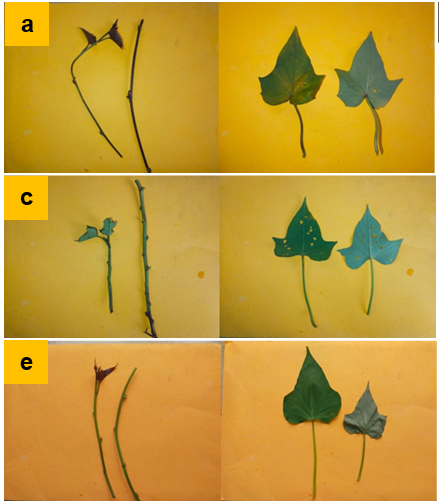Morphological Characterization and In Vitro Culture Optimization of Purple-Fleshed Sweet Potato (Ipomoea batatas L. Poiret) Accessions
DOI:
https://doi.org/10.70158/buitenzorg.v2i1.15Abstract
Purple-fleshed sweet potato (Ipomoea batatas L. Poiret) is a functional food crop known for its high anthocyanin content and nutritional value. This study aimed to characterize the morphological traits of stem and leaf organs from seven purple-fleshed sweet potato accessions and to evaluate the effectiveness of in vitro culture techniques for their conservation. Morphological traits were assessed using a standardized scoring system and analyzed using Principal Component Analysis (PCA) and cluster analysis. Results showed significant variation among accessions, with Ungu Lonjong appearing genetically distinct, while Ayamurasaki, KT Lampa, and Local NTT exhibited high similarity. In vitro culture analysis involved the sterilization and cultivation of explants on Murashige and Skoog (MS) medium and minimal growth medium. The highest sterilization success rate was observed in Ungu Lonjong (78.3%), whereas Local NTT showed the highest contamination. This study demonstrates the potential of combining morphological data and tissue culture for effective characterization, conservation, and future purple-fleshed sweet potato germplasm breeding.
Keywords: Ipomoea batatas, germplasm conservation, morphological characterization, tissue culture
Downloads
References
Abubakar, A. S., Yahaya, S. U., Shaibu, A. S., Ibrahim, H., Ibrahim, A. K., Lawan, Z. M., & Isa, A. M. (2018). In vitro propagation of sweet potato (Ipomoea batatas (L.) Lam.) cultivars. Agricultural Science Digest, 38(1), 17–21. https://doi.org/10.18805/ag.D-128
Balitkabi (2021). Potensi ubi jalar ungu sebagai pangan fungsional. Retrieved from https://balitkabi.litbang.pertanian.go.id/infotek/potensi-ubijalar-ungu- sebagai-pangan-fungsional
Dewi, N., Dewi, I. S., & Rootika, I. (2014). Pemanfaatan teknik kultur in vitro untuk konservasi plasma nutfah ubi-ubian. Jurnal AgroBiogen, 10(1), 34–44.
Dewi, R., & Sutrisno, H. (2014). Karakter agronomi dan daya hasil tiga klon ubi jalar ungu (Ipomoea batatas) di lahan masam Lampung. Jurnal Penelitian Pertanian Terapan, 14(1), 15–21.
Evgenidis, G., Traka-Mavrona, E., & Koutsika-Sotiriou, M. (2011). Principal component and cluster analysis as a tool in the assessment of tomato hybrids and cultivars. International Journal of Agronomy, 2011, 697879. https://doi.org/10.1155/2011/697879
Fitriani, Y., Wijana, G., & Darmawati, I. A. P. (2019). Teknik sterilisasi dan efektivitas 2,4-D terhadap pembentukan kalus eksplan daun nilam (Pogostemon cablin Benth) in vitro. Jurnal Agriculture Science and Biotechnology, 8(1), 41–52.
Ginting, E., Utomo, J. S., Yulifianti, R., & Jusuf, M. (2011). Potensi ubi jalar ungu sebagai pangan fungsional. Iptek Tanaman Pangan, 6(1), 118–136.
Govindaraj, M., Vetriventhan, M., & Srinivasan, M. (2015). Importance of genetic diversity assessment in crop plants and its recent advances: an overview of its analytical perspectives. Genetic Research International, 2015, 431487. https://doi.org/10.1155/2015/431487.
Hetharie, H., Raharjo, S. H. T., & Jambormias, E. (2018). Pengelompokan klon-klon ubi jalar berdasarkan analisis gerombol, komponen utama dan biplot dari karakter morfologi. Jurnal Agronomi Indonesia, 46(3), 276–282.
Ishaq, I., Yulyatin, A., & Supriyadi, H. (2019). Karakter penciri keragaman sumber daya genetik ubi jalar Jawa Barat. Buletin Plasma Nutfah, 25(2), 107–112.
Janmohammadi, M., Movahedi, Z., & Sabaghnia, N. (2014). Multivariate statistical analysis of some traits of bread wheat for breeding under rainfed conditions. Journal of Agricultural Sciences, 59(1), 1–14. https://doi.org/10.2298/JAS1401001J
Nair, A. G. H., Vidya, P., Ambu, V., Sreekumar, J., & Mohan, C. (2017). Genetic diversity studies in cultivated sweet potato (Ipomoea batatas [L.] Lam) revealed by simple sequence repeat markers. International Journal of Advanced Biotechnology Research, 7(1), 33–48.
Prayudha, H. N., Noerizzki, A. M., Maulana, H., Ustari, D., Rostini, N., & Kurniawan, A. (2019). Keragaman genetik klon ubi jalar ungu berdasarkan karakter morfologi dan agronomi. Buletin Palawija, 17(2), 94–101.
Rosadi, D., Sufiat, S., & Hamid, Y. H. (2020). Daya terima konsumen terhadap cita rasa rangginang ubi jalar ungu (Ipomoea batatas L.). Ilmiah Mahasiswa Pendidikan Kesejahteraan Keluarga, 5(3), 78–84.
Rosidah (2014). Potensi ubi jalar sebagai bahan baku industri pangan. TEKNOBUGA, 1(1), 44–52.
Sabda, M. (2018). Keragaman umur simpan 100 aksesi ubi jalar pada konservasi in vitro. Prosiding Seminar Nasional BPTP Papua Tahun 2017. Balai Besar Pengkajian dan Pengembangan Teknologi Pertanian, Badan Penelitian dan Pengembangan Pertanian, Kementerian Pertanian.
Wadl, P. A., Olukolu, B. A., Branham, S. E., Jarret, R. L., Yencho, G. C., & Jackson, D. M. (2018). Genetic diversity and population structure of the USDA sweetpotato (Ipomoea batatas) germplasm collection using GBSpoly. Frontiers in Plant Science, 9, 1–13. https://doi.org/10.3389/fpls.2018.01166
Winayu, A. K. (2020). Analisa kadar karbohidrat pada ubi jalar (Ipomoea batatas L.) kuning dan ungu sebagai alternatif makanan bagi penderita diabetes mellitus (Studi di Pasar Legi Kabupaten Jombang). Sekolah Tinggi Ilmu Kesehatan Insan Cendekia Medika, Jombang. Retrieved from https://repository.itskesicme.ac.id/id/eprint/3987/3/1_KTI_AnindyaKusumaWinayu.pdf
Ziraluo, Y. P. B. (2021). Metode perbanyakan tanaman ubi jalar ungu (Ipomoea batatas Poiret) dengan teknik kultur jaringan atau stek planlet. Jurnal Inovasi Penelitian, 2(3), 1037–1046.

Downloads
Published
How to Cite
Issue
Section
License
Copyright (c) 2025 Buitenzorg: Journal of Tropical Science

This work is licensed under a Creative Commons Attribution-ShareAlike 4.0 International License.
The article is licensed under a Creative Commons Attribution-ShareAlike 4.0 International License (CC BY-SA), which allows both Authors and Readers to copy and distribute the material in any format or medium, as well as modify and create derivative works from it for any purpose, provided that appropriate credit is given (by citing the article or content), a link to the license is provided, and it is indicated if any changes were made. If the material is modified or used to create derivative works, the contributions must be distributed under the same license as the original.





